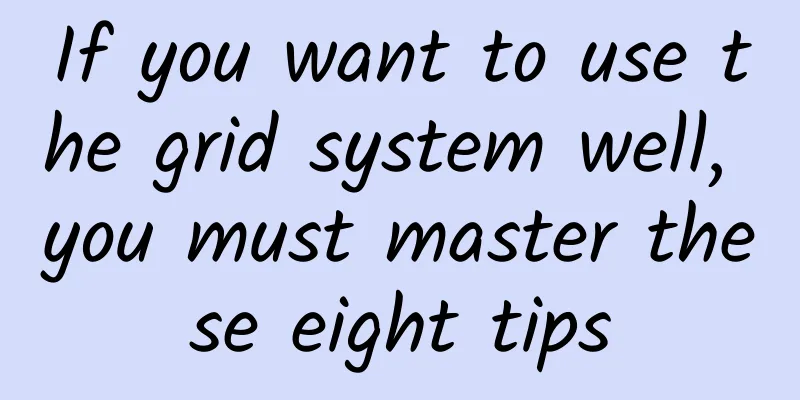If you want to use the grid system well, you must master these eight tips

|
Hi, I'm Caiyun. White space and grids are the foundation of any design. Once you really master and use them correctly, grids will help you design reliable and attractive design solutions. So, today I will share the grid design skills I have mastered in UI design. The article is not long, read it carefully, and you will definitely gain something. What is Grid Design?The grid is the foundation of any well-designed interface and can be thought of as a framework for your layout. This framework helps organize UI elements, guide users, and define the various parts of your design. Common termsThe grid is made up of grid units. The layout is placed on the grid, which contains a certain number of columns, with margins on the left and right sides of the columns and padding between each column, also called a gutter. Tip 1: Choose the right number of columnsAlthough the 12-column Bootstrap-like grid is the most popular choice, it is not mandatory. When choosing a grid, determine how many columns to use based on the actual needs of the design, and make sure that there are no more or less columns. (Note: You can define the number of columns based on the main size of your interface. Common ones can be set in multiples of 4 or 8) Tip 2: Understand the constraintsAlways use the device screen you are designing for as a benchmark, understand the usage habits of your target users, take advantage of those limitations and learn to design with them. Most common screen resolutions (px)
Tip 3: Keep the spacing consistentUnify vertical and horizontal spacing to make layouts more attractive and consistent. Tip 4: Use the baseline gridUse a baseline grid to align content and bring visual consistency to text and layout elements. Bonus tip – adjust font line height to match the baseline grid. For example, if you choose 4px as your baseline/grid unit, to align text, you need to set the font's line-height to a multiple of that unit, i.e. the line height should be 4, 12, 32, 64, etc. Tip 5: Use frames and colorsUse the frame as a tool to focus the user's attention on a certain part of the layout, adding extra visual weight where needed. (Note: For example, changing the color of a card to highlight a certain data is common when making a background interface) Tip 6: Break the GridExclude certain elements from the grid and use this decomposition technique to add value and make certain parts of your design stand out and guide the user. Tip 7: Dynamic GridMake sure the layout you design can adapt to common screen sizes and adapt to multiple terminals to maintain a consistent experience. (Note: Changing the layout does not change the grid system, and the spacing can still remain unchanged) Tip 8: Use the grid system flexiblyDesigning without a grid is certainly possible for small projects, but for relatively large projects, using a grid is very necessary, even mandatory. Learning to design with a grid is not a rote process, you need to observe the layout from time to time and find the most creative solution for your needs. |
<<: Implementing source code coverage for Swift step by step
>>: iOS 15.5 official version has a big bug that will eat up all your data
Recommend
Geely: 70%-80% of electric vehicles are powered by dirty energy
Recently, the 2022 World Power Battery Conference...
Virtual reality concerns: What you don’t see may not be harmless
The enthusiasm of capital, the hype of the media,...
Advertising your own products is the correct way to promote your products!
When it comes to promotion , most people think of...
Is the agency fee for Wuyishan voting mini program high? Wuyishan voting mini program agency fees and process
How much does it cost to be an agent for a voting...
Break down event planning and promotion in three steps!
Many times, when we organize a marketing campaign...
How to increase user growth? Take Pinduoduo and Xiaohongshu as examples
Yesterday, I had the opportunity to listen to mor...
Alipay APP changes its icon: 2021 "Collect Five Blessings" is here, with more ways to play this year
There is less than a month left until the 2021 Sp...
Analysis of advertising placements for clothing, shoes and bags categories in November!
Note: The clothing, shoes and bags related data i...
APP operation tips: How to retain users for a good APP!
You know APP development, but do you know APP oper...
Analysis of the Unicorn NetEase Cloud Music’s Competitive Products with Over 300 Million Users!
Before NetEase Cloud Music launched its first ver...
Anhui Shexian County College Entrance Examination Chinese and Mathematics Test Papers to be Replaced
Anhui Shexian County College Entrance Examination...
If your child doesn't talk, does that mean he or she is "socially anxious"? Maybe you should learn about "selective mutism"
gossip Children who can talk happily and communic...
When operating mobile game activities, there are 7 minefields that you must avoid!
An unreasonable operation plan and poorly impleme...
Is your home broadband signal always insufficient? Click here!
With the popularization of the Internet, routers ...
Is it a pitfall for brands to build private communities?
In 2020, the emergence of cases such as Perfect D...









